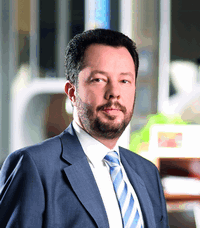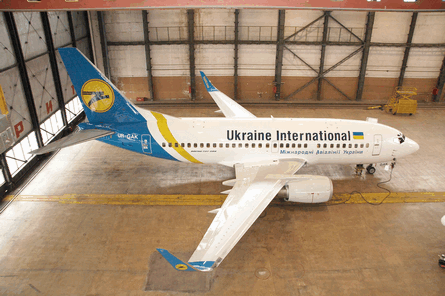Yuri Miroshnikov has seen Ukraine International Airlines nearly triple in size since becoming president in 2004 and is preparing the mostly government-owned flag carrier for more rapid and profitable growth despite record high fuel prices.
UIA’s traffic has increased at least 15% annually since 2004, including a 42% jump last year to 1.44 million passengers. In the first half of this year it carried 760,000 passengers, another 25% increase over the same period last year.
The Ukraine is one of the fastest growing air transport markets in the world, having registered 23% growth overall last year to over 9 million passengers. Miroshnikov expects growth will slow down this year but will still be 16% to 17% as demand remains strong. “For the Ukraine, the market is not yet softening. What we may see is a reduction in the pace of growth,” he says.
 |
|---|
The Ukrainian market is still smaller than what it was during its peak before the fall of the Soviet Union, when it consisted of about 18 million passengers annually. After the Ukraine became independent Miroshnikov says the market dropped “to a rock bottom level but then it started to recover in 1999. Since then it’s been very strong and doubled every three to four years. That’s why it’s so hot now. It really started from scratch.”
But Miroshnikov adds that the market was very different back in the late 1980s because back then 90% of the market was domestic. Today it is only 10% domestic.
The Ukrainian market is now also heavily focused on charters, which accounted for more than a quarter of the total market last year. Miroshnikov says charters is the fastest growing segment partly because there is no room for more scheduled flights under Ukraine’s bilaterals with Egypt and Turkey, the country’s two largest leisure markets.
 |
|---|
"in the late 1980s because back then 90% of the market was domestic. Today it is only 10% domestic."Yuri Miroshnikov |
“The leisure market is actually booming and growing twice as fast as the scheduled market in the Ukraine,” Miroshnikov says. Last year 31% of UIA’s passengers, or about 600,000, were carried on charter flights. Leisure travel has soared in recent years, especially to Egypt and Turkey because Ukrainians do not need visas to visit these countries, as income levels in the Ukraine have increased. “For the moment these markets are absorbing the fuel price and are still growing,” Miroshnikov says.
The Ukrainian cargo market is also growing rapidly and UIA has just taken delivery of its first freighter, a Boeing 737-300F. Miroshnikov says UIA has an option to add a second 737-300 freighter next year: “If the 737 freighter operation shows profitability we may add a second aircraft. We don’t care what it is – business passenger or leisure passenger, freight or mail. If it brings in money let’s do it. In this environment you can’t be choosy.”
UIA now follows a point-to-point model, although it eventually aims to carry transfer passengers through its Kiev hub. Miroshnikov says about 70% to 75% of UIA’s operation is at Kiev’s main airport, Borispol, but there are not many transfer opportunities because nearly all traffic for UIA is westbound. “The Ukrainian market is very imbalanced – 90% of the traffic flows are westbound,” he says.
UIA is now looking to further grow its strong European network with additional frequency to major cities and new routes to secondary cities. For example, Miroshnikov says UIA is looking to upgrade its current charter service to Nice to a scheduled service and to add cities in Italy to complement its current services to Rome and Milan.
But Miroshnikov says UIA is also interested in opening new eastbound connections, in particular to the Gulf and the Caucasus. “The bigger priority will be to find new destinations in the east,” he says.
UIA’s planned acquisition of new narrowbody and widebody aircraft should support its plans to expand to the east. UIA now operates 16 Boeing 737 classics but plans to place an order for 30 to 35 next-generation narrowbodies by the end of this year.
 |
|---|
UIA earlier this year committed to leasing four new 737-800s from Aviation Capital Group starting in 2009 and 2010. But Miroshnikov says the deal does not mean UIA will stick to Boeing for its long-term needs and he is currently evaluating both the 737NG and Airbus A320 families. “We’re working in parallel with Airbus and Boeing on this fleet replacement decision,” he says. “Our aim is to make a decision this year.”
The carrier is looking for between four and six new narrowbodies per year from 2011 or 2012, although Miroshnikov says it will likely have to wait until 2013 or 2014 as neither Airbus nor Boeing currently have earlier delivery slots.
Miroshnikov says UIA needs about two aircraft per year to keep up with growth while the other two to four aircraft per year would be used to replace its existing 737s as their leases expire. He says a decision possibly adding widebodies will be made later, “probably in or after 2010”. He adds: “We’re monitoring the situation and we’ll take a decision when the market is ready.”
The widebodies will be used to open new routes to the east because interlines and codeshares allow UIA to “generate very good revenues from North America without serving there”. UIA passengers now connect to onward points in Europe and the Americas through interline and codeshare agreements with several European carriers. “We don’t need widebodies to serve North America. We need them to serve the east. There are nearly no flights to the east,” Miroshnikov says.
Despite the imbalanced network UIA is highly profitable, with an $18 million operating profit reported last year on $277 million in revenues. Miroshnikov says UIA has turned profits for eight consecutive years and expects to remain profitable in 2008 despite the extra fuel costs. To offset the skyrocketing fuel costs, UIA is focusing now on increasing its load factor. Miroshnikov says the carrier’s load factor has been averaging 70% this year, up from 64% last year and only 54% in 2006. He says 70% is sufficient to make money even with the record high oil prices because yields are strong on its routes and “our unit costs are at the level of low cost carriers”.
“Definitely we’re looking for a profit [in 2008]. Even under a pessimistic scenario we’ll be profitable,” he says.
Miroshnikov joined UIA in 1993, one year after the carrier was established by the post-Soviet Ukrainian government. Although he wasn’t part of UIA’s management team at the time of the launch, Miroshnikov was closely involved with Ukraine’s CAA and played a role in issuing the carrier’s operating certificate and permits. “We were working in the same building. It was like a big family,” he recalls, adding that establishing UIA was considered a big deal at the time because it was “the first real Ukrainian airline”.
 |
|---|
Miroshnikov initially joined UIA as the assistant to the president and was later promoted to vice-president commercial and senior vice-president before being appointed to his current position of president in 2004.
When he joined UIA there was only one competitor, Air Ukraine, which was originally part of Aeroflot. But that quickly changed as new airlines were rapidly launched to compete against UIA. “By the mid-1990s the number of airlines had grown to like 100,” he says.
There are still about 50 carriers operating in the Ukraine but only four to six are “serious players”, according to Miroshnikov. UIA and most of the Ukraine’s other major carriers remain government-owned. UIA is 62% government owned. Austrian Airlines is the largest private shareholder, with a 22% stake.
Miroshnikov says over time he expects the government will reduce its stake, perhaps to 40%, but this will be a long process and will unlikely result in full privatisation.
“Privatisation is a complicated legal procedure in the Ukraine,” he says. “Clearly it’s not an issue of one year. We’re on the right track. I’m pretty sure in the end it will go to a reduction of the government stake.” The government now only owns 23% of UIA’s main competitor and the Ukraine’s other major international carrier, AeroSvit. The government has discussed several times the idea of merging UIA, Aerosvit and perhaps a third carrier but Miroshnikov says “it’s not relevant now. I can’t say it’s dead but at the moment it’s not an issue for either carrier or the government.”
He adds: “Internal competition between carriers to some extent is good because it keeps us in shape. One combined carrier may be weaker.”
Source: Airline Business
















